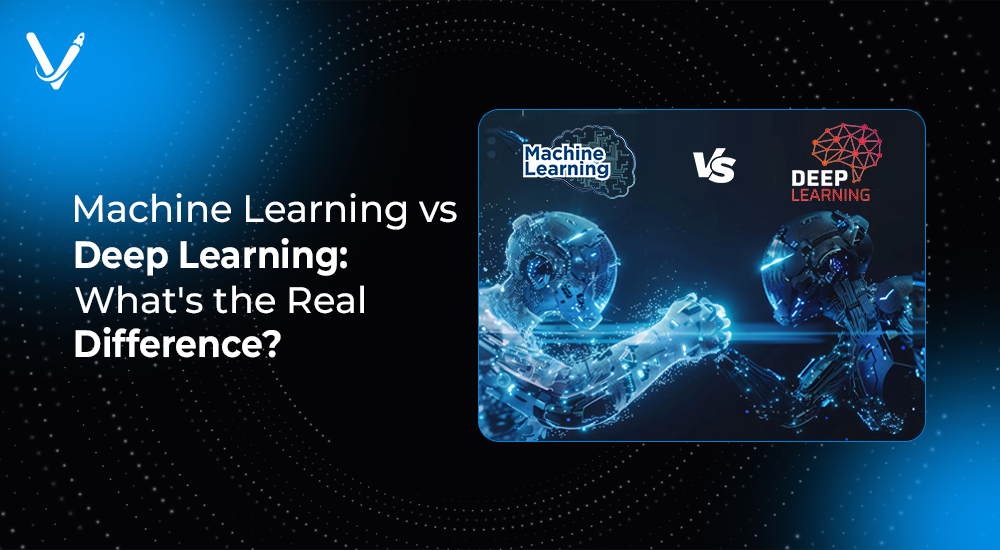Machine Learning vs Deep Learning: What's the Real Difference?


- May 28, 2025



Artificial Intelligence (AI) has moved far beyond science fiction into a world where machines can learn, make decisions, and even mimic human perception. As this field evolves, two terms dominate the conversation—Machine Learning vs. Deep Learning. These buzzwords are often used interchangeably, yet they refer to distinct technologies with different strengths, weaknesses, and use cases.
So, what is the difference between deep learning and machine learning? This article breaks it down in plain English—no unnecessary complexity, just clear explanations, practical examples, and the real implications for your business or project.
We’ll explore the concepts in machine learning, walk through different types of machine learning, dive into real deep learning examples, and answer the ultimate question: which one should you use?
Let’s dive into the fascinating world of smart machines.
Machine Learning (ML) is a subset of AI where computers are trained to learn from data and make predictions or decisions without being explicitly programmed. It’s like teaching a child how to identify fruits using examples, rather than giving them a rulebook.
Deep Learning (DL) is a specialized branch of machine learning that uses artificial neural networks to simulate human brain activity. These networks are “deep” because they contain multiple layers that process information hierarchically.
Instead of manually selecting features, deep learning models learn features on their own by processing raw data.
So, what is the difference between deep learning and machine learning in practical terms?
Aspect | Machine Learning | Deep Learning |
Feature Engineering | Required | Not Required (automatic) |
Data Requirements | Works with small to medium datasets | Needs large datasets |
Interpretability | More transparent and explainable | Acts like a black box |
Training Time | Faster on small datasets | Slower due to complex layers |
Hardware Dependency | Can run on CPUs | Requires GPUs for best performance |
Example Use Cases | Predictive analytics, forecasting | Image recognition, NLP, autonomous vehicles |
Understanding machine learning vs neural networks is essential because neural networks form the backbone of deep learning.
Neural networks mimic how the human brain works, processing data in layers and learning relationships through weights and biases.
Machine learning isn’t a one-size-fits-all technology. It’s divided into different paradigms, each suited for specific problems.
Deep learning has led to some of the most exciting advances in AI.
Example: Google Photos automatically tagging people, pets, or places. Convolutional Neural Networks (CNNs) identify complex patterns in pixel data.
Example: ChatGPT, Alexa, and Siri rely on deep learning to understand and generate human-like text. Models like transformers and LSTMs make this possible.
Example: Tesla uses deep learning to detect lanes, signs, and other vehicles. It combines camera feeds and sensor data for real-time decisions.
Example: Deep learning algorithms analyze X-rays, MRIs, and CT scans to detect tumors, pneumonia, or COVID-19 with high accuracy.
Knowing the difference between deep learning and machine learning is valuable only if you understand which one to apply and when.
Machine Learning Approach:
Uses purchase history, product ratings, and browsing behavior to predict next purchase.
Deep Learning Approach:
Learns patterns in session behavior, image features of products, and text in reviews to personalize recommendations in real time.
Result: Deep learning provides better personalization but requires more data and computational resources.
Machine Learning:
Rules-based logistic regression models catch known fraud patterns.
Deep Learning:
Recurrent Neural Networks (RNNs) detect complex sequential anomalies and adapt to new fraud tactics.
Not always. In many cases, traditional machine learning can outperform deep learning, especially with smaller datasets.
All deep learning uses neural networks, but not all neural networks are deep enough to be considered deep learning.
Thanks to cloud platforms like AWS, Azure, and Google Cloud, anyone can experiment with deep learning without owning GPUs.
Rather than a rivalry, the future lies in combining both paradigms.
Machine learning vs. deep learning isn’t a battle—it’s a toolkit. Each has its strengths. Choosing between them should depend on your data size, interpretability needs, hardware availability, and use case complexity.
At Vasundhara Infotech, we specialize in custom AI solutions tailored to your business goals. Whether you’re building a fraud detection engine, a smart assistant, or an image classifier, we help you pick the right tools—and build it right.
Ready to implement smart AI in your product?
Contact our expert team at Vasundhara Infotech and let’s bring your idea to life.
Copyright © 2025 Vasundhara Infotech. All Rights Reserved.